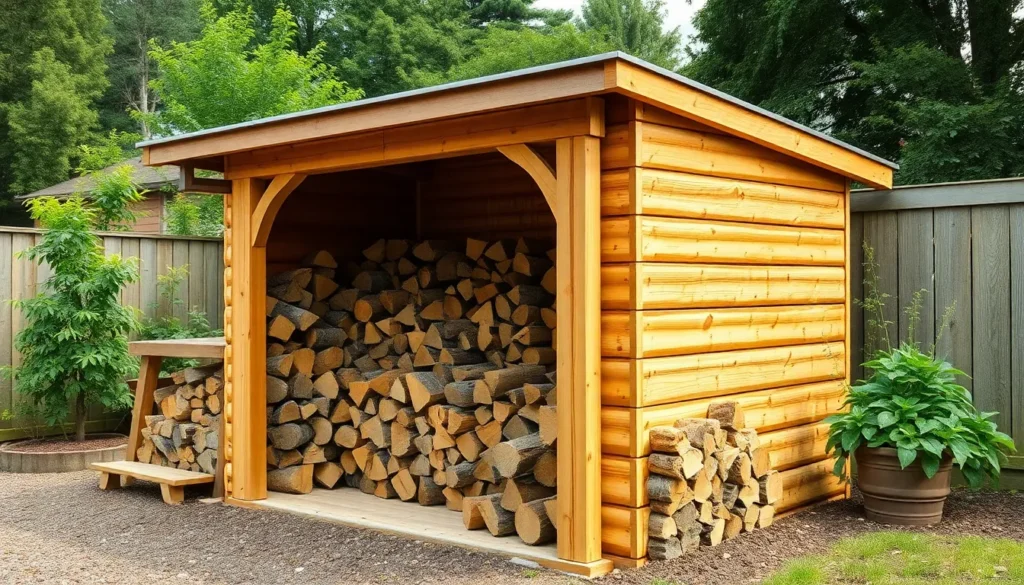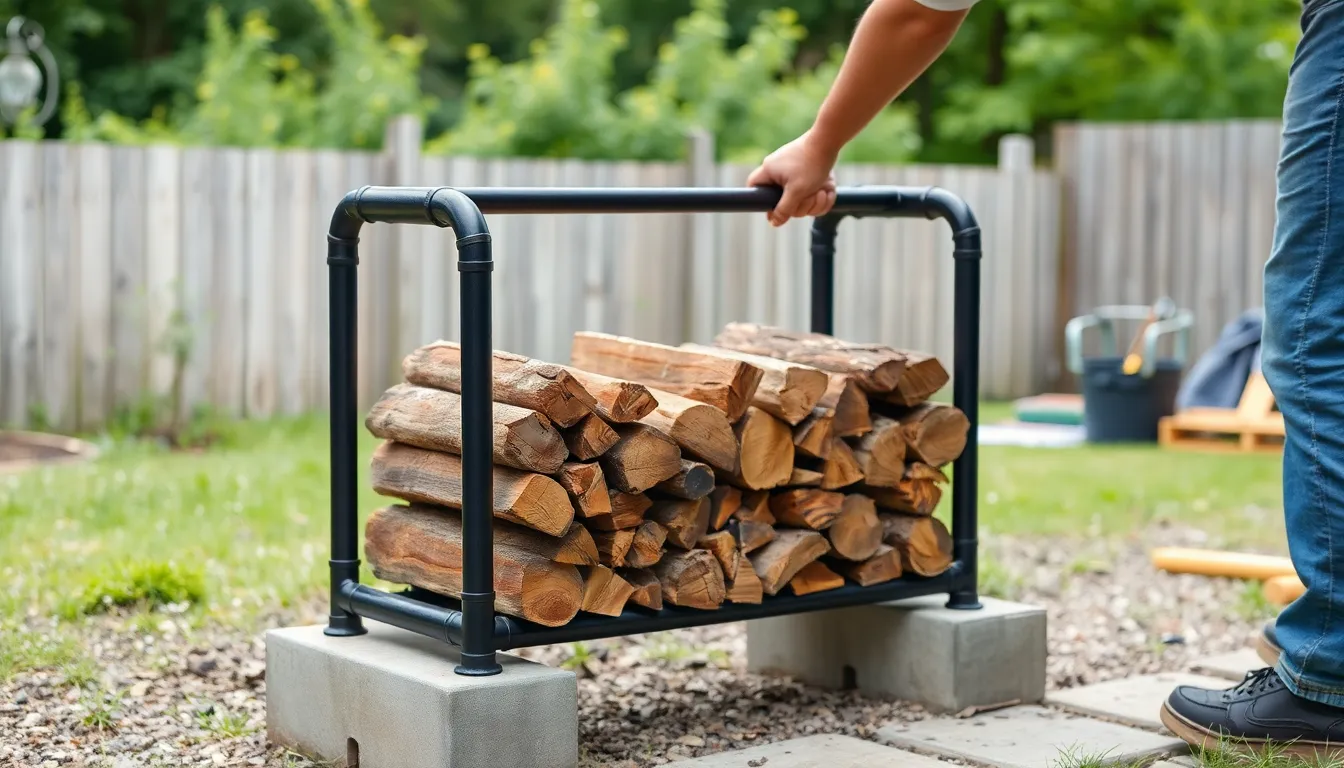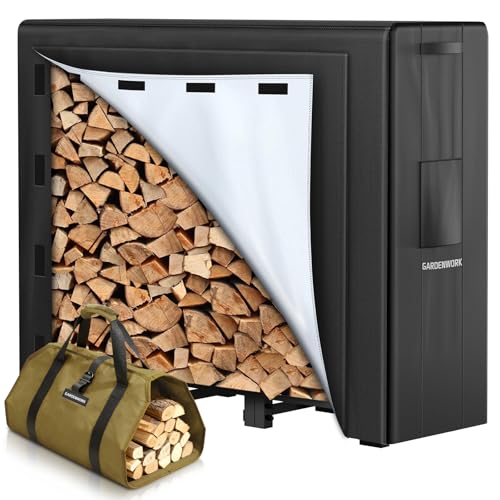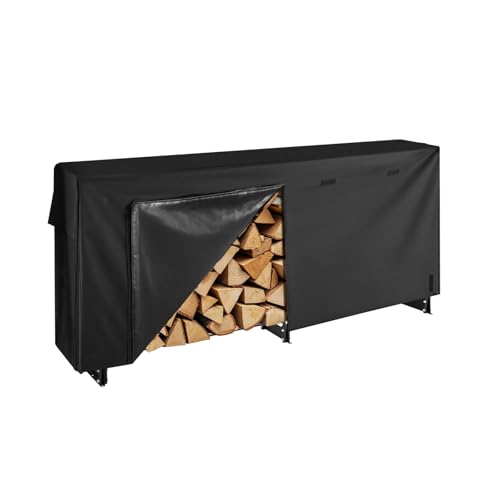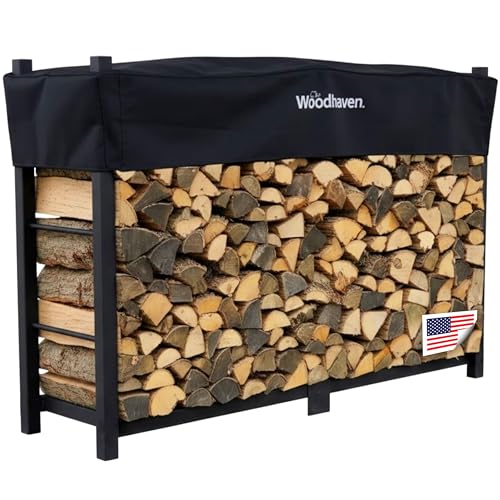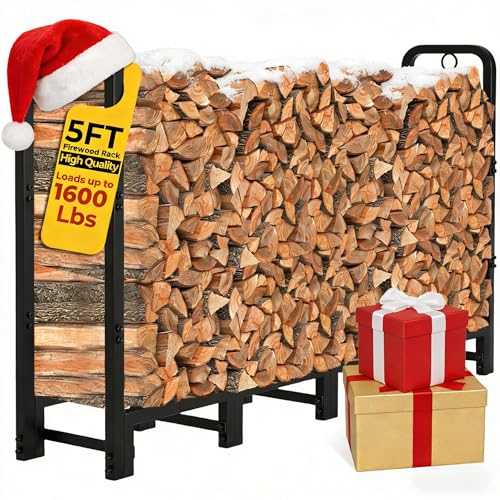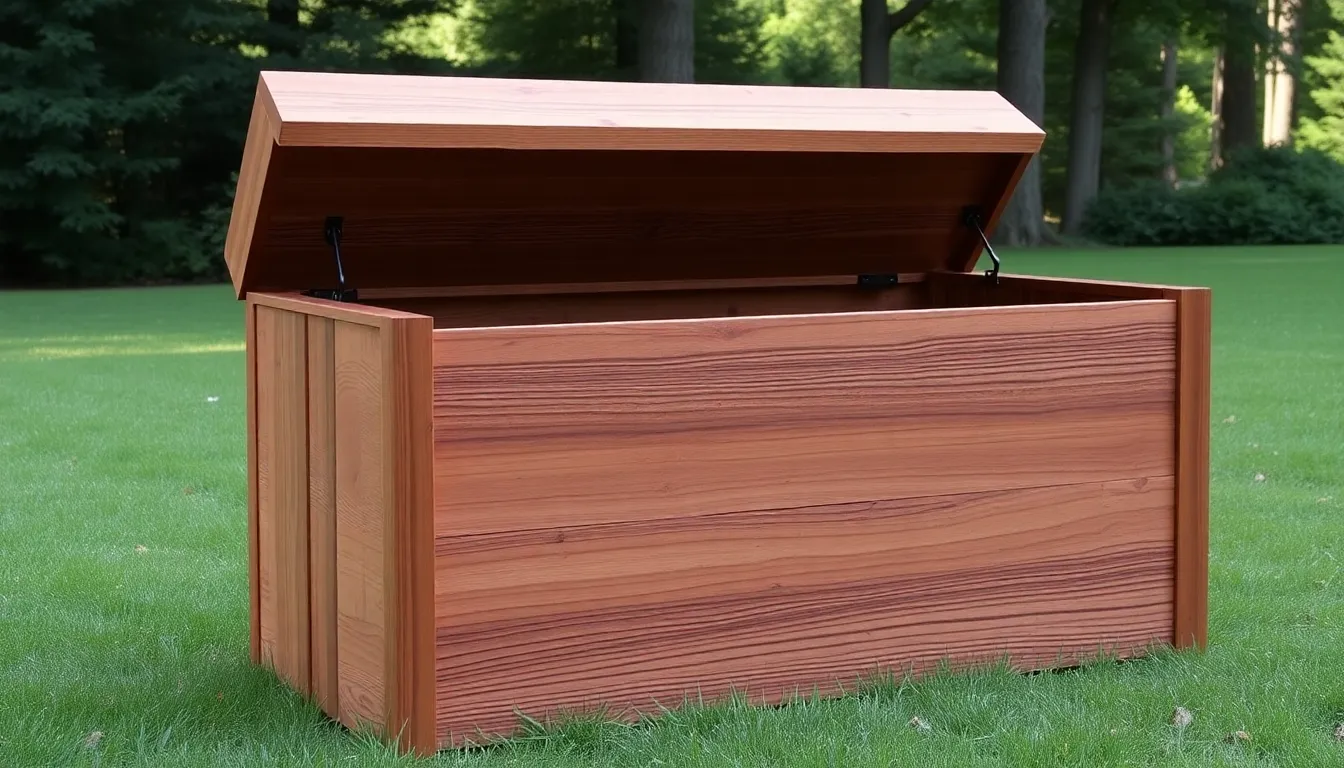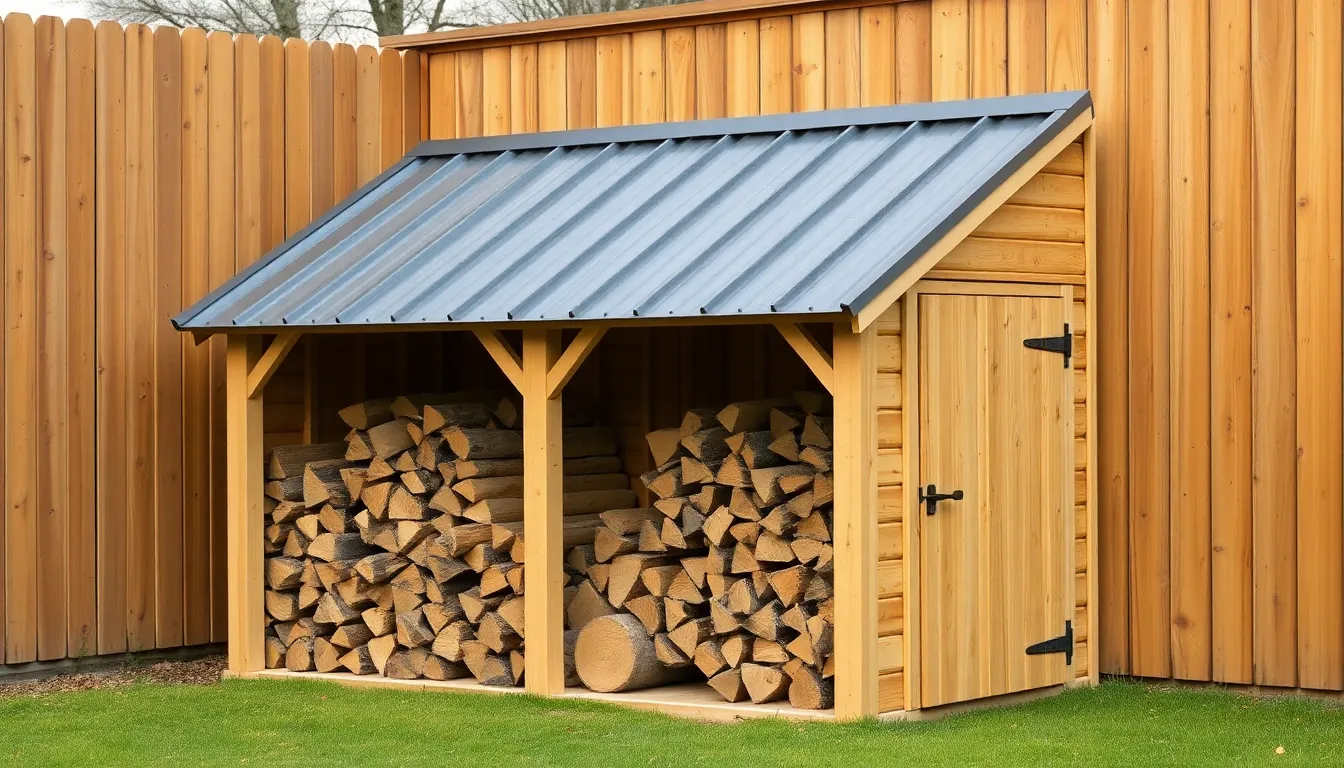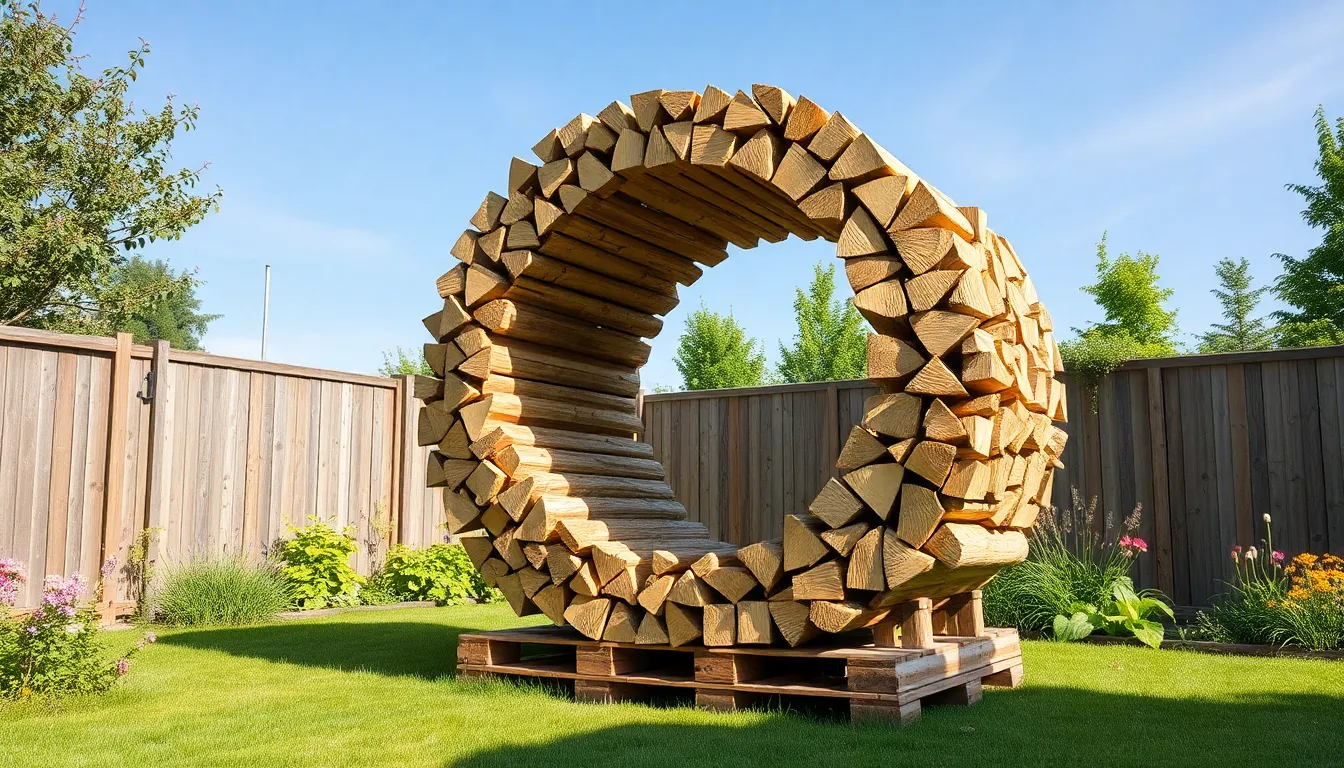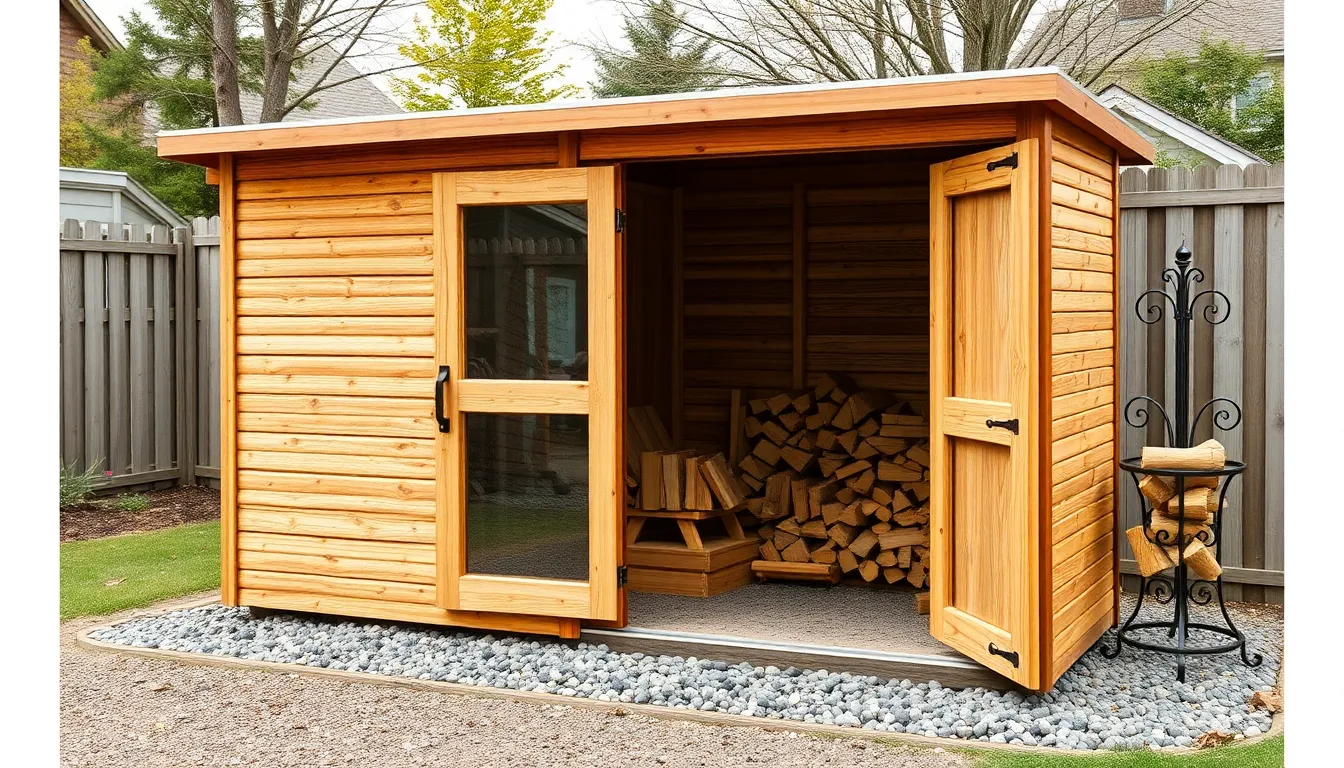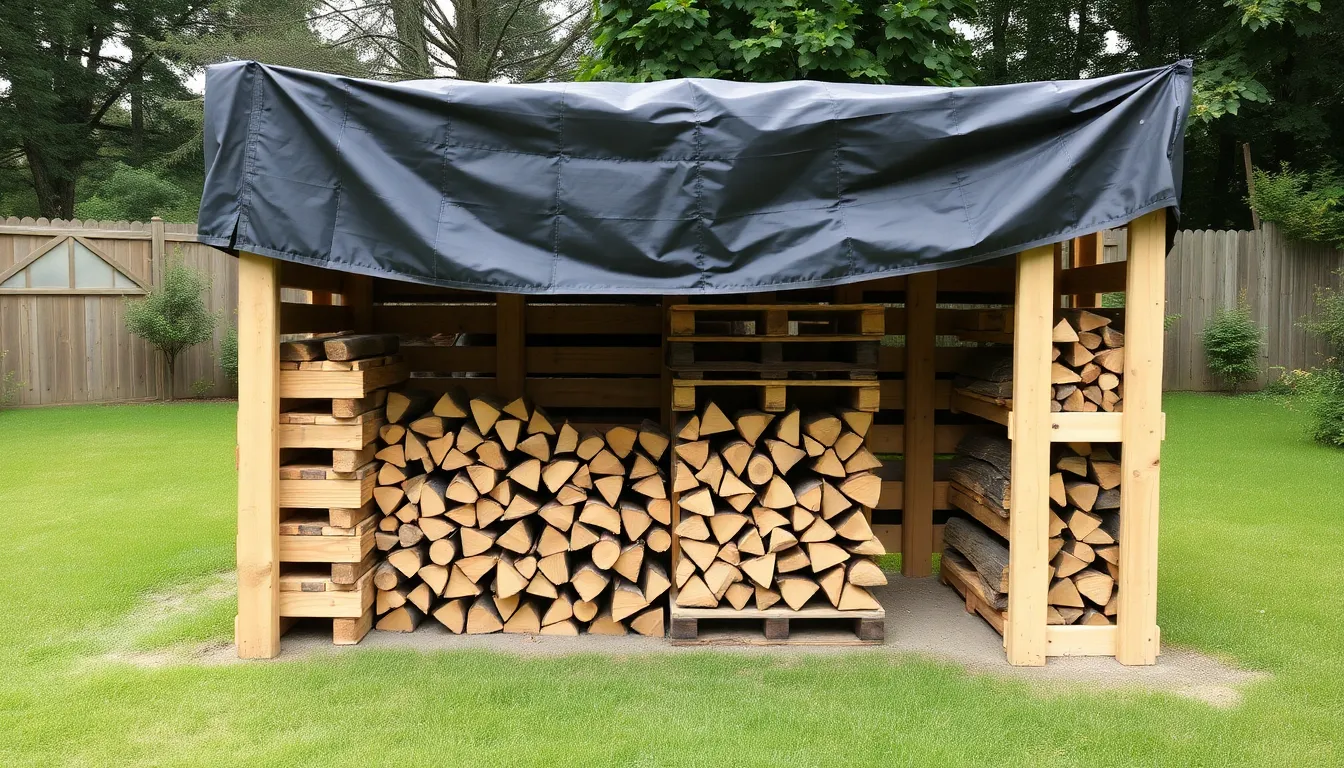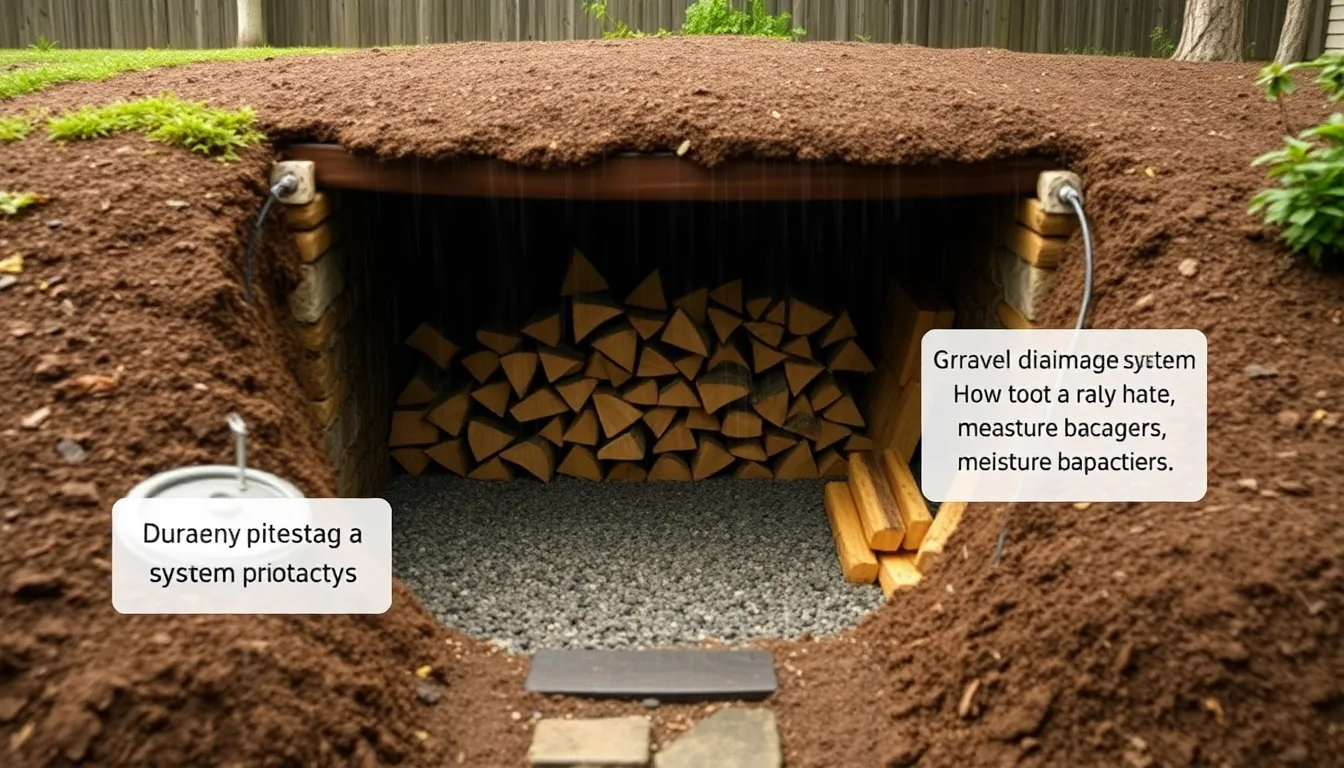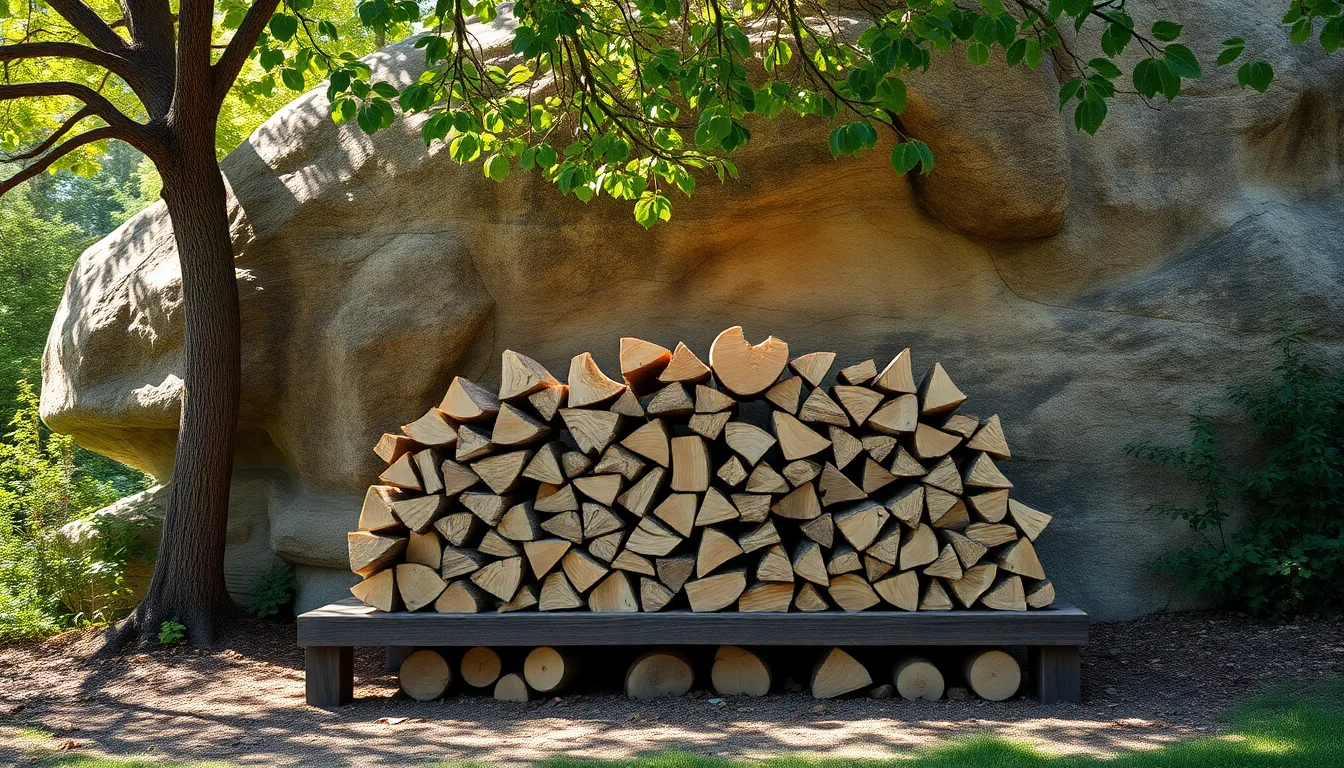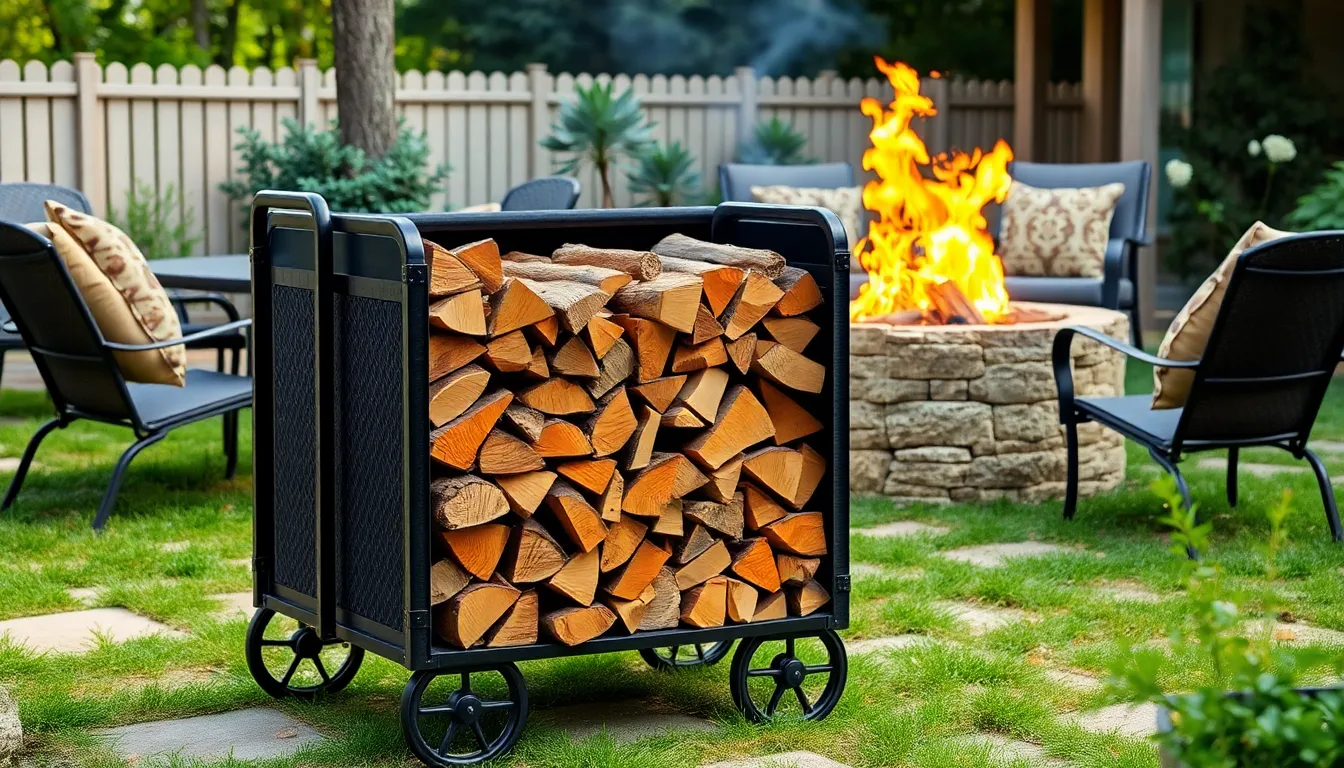Winter’s coming and we’re all thinking about those cozy nights by the fire. But nothing kills the mood quite like soggy waterlogged wood that won’t light or produces more smoke than heat. That’s why smart firewood storage isn’t just convenient – it’s essential for anyone who wants to enjoy their fireplace or wood stove all season long.
We’ve all been there: rushing outside in the rain to grab an armload of damp wood only to struggle with a smoky stubborn fire. Proper outdoor firewood storage solves this problem while keeping your wood seasoned dry and ready to burn. The right storage solution also protects your investment since quality firewood isn’t cheap.
Whether you’re working with a small patio or sprawling backyard we’ll show you creative storage ideas that keep your wood accessible organized and weather-protected. From simple DIY answers to stylish structures that enhance your outdoor space these storage options will transform how you manage your firewood supply.
Build a Classic Log Shed for Maximum Protection
Building a dedicated log shed represents the gold standard for firewood storage answers. We’ll transform your outdoor space with a structure that shields your wood from harsh weather while maintaining excellent accessibility.
Choose Weather-Resistant Materials
Pressure-treated lumber forms the backbone of any durable log shed construction. We recommend using cedar or redwood for siding materials since these woods naturally resist moisture and insect damage without requiring chemical treatments. Galvanized steel hardware prevents rust formation that can weaken joints over time.
Metal roofing panels offer superior longevity compared to traditional asphalt shingles. We’ve found that corrugated steel or aluminum sheets withstand heavy snow loads while reflecting heat during summer months. Composite decking materials work exceptionally well for flooring since they won’t rot or warp when exposed to ground moisture.
Concrete footings elevate your structure above ground level and prevent moisture wicking. We suggest using 4×4 inch treated posts anchored at least 18 inches deep for optimal stability. Gravel bases around footings improve drainage and reduce frost heaving in colder climates.
Ensure Proper Ventilation Design
Strategic gap placement between siding boards creates natural airflow throughout your firewood storage area. We space horizontal boards approximately 1/2 inch apart to allow air circulation while preventing rain penetration. Vertical gaps work equally well but require careful attention to prevailing wind direction.
Raised flooring systems promote air movement beneath your wood stack. We construct platforms using 2×4 inch treated lumber spaced 16 inches on center with 3/4 inch gaps between deck boards. This design prevents ground moisture from reaching your firewood while encouraging bottom-up ventilation.
Gable end vents maximize cross-ventilation through your shed structure. We install louvered vents near the roofline on opposite ends to create steady airflow patterns. Ridge vents along the peak provide additional exhaust points for moisture-laden air that rises naturally.
Add a Sloped Roof for Water Runoff
Minimum pitch requirements ensure effective water drainage from your log shed roof. We recommend maintaining at least a 4/12 slope (4 inches of rise per 12 inches of horizontal run) for metal roofing systems. Steeper pitches like 6/12 shed snow more effectively in northern climates.
Gutter installation channels rainwater away from your firewood storage foundation. We position gutters with a slight downward slope toward downspouts placed at structure corners. Splash blocks or underground drainage pipes direct water at least 6 feet from the shed perimeter.
Overhang extensions provide additional weather protection for your stored firewood. We extend roof lines 12 to 18 inches beyond the shed walls on all sides to prevent wind-driven rain from reaching your wood stacks. Fascia boards along overhangs add structural support while creating clean finished edges.
Create a Simple Firewood Rack System
Building your own firewood rack doesn’t require advanced carpentry skills or expensive materials. We can construct effective storage answers using basic materials like untreated lumber or metal pipes to create rectangular frames that keep wood elevated and organized.
Use Metal Brackets for Durability
Metal brackets provide the strongest foundation for outdoor firewood storage systems. We recommend using black steel pipe with elbow fittings to create weather-resistant frameworks that won’t warp or deteriorate like wooden alternatives. These brackets prevent wood from collapsing and maintain neat, stable stacks even during harsh weather conditions.
Installing pipe fittings creates both functional and decorative storage answers that complement modern outdoor spaces. We’ve found that metal racks work exceptionally well in covered areas where they’re protected from direct moisture exposure. Steel brackets also eliminate the maintenance requirements associated with wooden structures, making them ideal for long-term outdoor use.
Space Logs for Air Circulation
Proper airflow prevents mold growth and accelerates the seasoning process for freshly cut wood. We should stack logs loosely with deliberate spacing between each piece to promote continuous air movement throughout the entire pile. Using slats or horizontal bars in rack construction automatically creates these essential gaps.
Elevating racks off the ground prevents moisture absorption from soil while promoting airflow underneath the wood pile. We can achieve this elevation using concrete blocks, treated lumber supports, or metal legs that raise the entire structure several inches above ground level. This spacing technique reduces decay and ensures our firewood burns efficiently when we need it most.
Consider Adjustable Height Options
Modular storage systems adapt to seasonal firewood quantities without requiring permanent structural changes. We can invest in folding or collapsible steel racks that expand during peak storage seasons and contract when wood supplies run low. These adjustable designs optimize space usage in smaller outdoor areas.
Height flexibility improves stacking ergonomics and reduces physical strain during loading and unloading tasks. We should look for rack systems that accommodate different log lengths and allow us to adjust storage capacity based on our heating needs throughout the year. Adjustable components also make it easier to clean underneath storage areas and perform routine maintenance tasks.
Construct a Firewood Storage Box
Building a dedicated storage box provides the ultimate protection for your firewood investment while keeping logs organized and accessible. This approach works particularly well when you need a more enclosed solution than traditional rack systems.
Select Rot-Resistant Wood Types
Cedar stands out as our top choice for firewood storage construction because it naturally repels moisture and insects while maintaining structural integrity for years. Redwood offers similar benefits with its natural oils that resist decay, making it perfect for outdoor applications where weather exposure is constant. Pressure-treated lumber provides an affordable alternative that withstands moisture damage and extends the lifespan of your storage structure significantly.
We recommend avoiding untreated pine or other softwoods that absorb water readily and deteriorate quickly in outdoor conditions. Metal racks constructed from galvanized steel offer excellent longevity, while vinyl sheds resist weathering and pest damage without requiring regular maintenance. These materials ensure your investment protects firewood effectively throughout multiple seasons.
Include Hinged Lids for Easy Access
Hinged lids transform firewood storage from a chore into a convenient daily task by allowing quick access to your wood supply. We suggest installing heavy-duty hinges that can support the weight of solid wood or metal lids without sagging over time. Piano hinges work exceptionally well for longer storage boxes because they distribute weight evenly across the entire lid span.
Adding a gas strut or chain limiter prevents the lid from opening too far and protects both the storage unit and anyone loading firewood. Weatherstripping around the lid edges creates a tighter seal that keeps rain and snow from penetrating the storage area. This design feature dramatically reduces the time needed to access firewood during harsh weather conditions.
Add Drainage Holes in the Bottom
Drainage holes measuring half an inch in diameter should be spaced every 12 inches across the bottom of your storage box to prevent water accumulation. We position these holes slightly off-center to avoid creating weak points in the structural framing while ensuring adequate water escape routes. Slatted bottoms using 1×4 boards with quarter-inch gaps provide superior drainage compared to solid bottoms with holes.
Elevating the entire storage unit on pressure-treated blocks or metal legs improves airflow underneath and prevents ground moisture from wicking into the wood. This elevation technique works especially well in areas with clay soil or poor natural drainage where water tends to pool after heavy rains. Adding a layer of gravel beneath elevated storage creates additional drainage and prevents weeds from growing underneath your firewood box.
Design a Lean-To Storage Structure
We’ll explore the lean-to design as our most efficient space-saving solution that takes advantage of existing structures while providing excellent protection for your firewood.
Use Existing Walls or Fences
Using an existing wall or fence as one side of your firewood storage dramatically reduces material costs while simplifying the entire construction process. We can mount horizontal support beams directly onto the wall or fence to create a solid foundation for our wood stacks.
Mounting horizontal beams at 16-inch intervals provides optimal support for heavy firewood loads. Extending corrugated roofing panels from the existing structure creates immediate overhead protection from rain and snow. Positioning the storage against a south-facing wall maximizes sun exposure for natural wood drying.
We’ll save approximately 25% on materials by utilizing existing structures, making this approach both economical and practical for most homeowners.
Install Proper Support Beams
Support beams form the critical foundation that ensures stability and safety for our lean-to firewood storage system. We recommend using 2″x4″ or 2″x6″ pressure-treated lumber for the main frame components to withstand weather exposure.
Resting base beams directly on concrete blocks elevates the structure and prevents moisture damage from ground contact. Securing connections with carriage bolts or lag screws provides the durability needed for long-term use. Spacing support posts every 4 feet maintains structural integrity even when fully loaded with seasoned firewood.
| Component | Material | Spacing | Fastener |
|---|---|---|---|
| Base beams | 2″x6″ pressure-treated | 4 feet | Carriage bolts |
| Support posts | 2″x4″ pressure-treated | 4 feet | Lag screws |
| Roof rafters | 2″x4″ pressure-treated | 24 inches | Galvanized screws |
Elevating the base 6 inches off the ground prevents wood from sitting in pooled water that accelerates decay.
Create Adequate Overhead Coverage
Adequate overhead coverage represents the most crucial element in preserving firewood quality throughout the seasons. We need to extend our roof beyond the front and sides of the storage by at least 12 inches to effectively shield wood from precipitation.
Installing metal roofing or corrugated panels provides superior durability and water runoff compared to traditional shingles. Angling rafters at a minimum 15-degree slope ensures rainwater flows off quickly without pooling. Adding gutters along the roof edge directs water away from the stored firewood below.
Creating proper ventilation gaps between roof panels allows air circulation while maintaining weather protection. Positioning the highest point of our lean-to roof at least 8 feet from the ground accommodates standard firewood stack heights. Installing fascia boards along the roof edges provides a finished appearance while preventing wind-driven moisture from entering the storage area.
The combination of metal roofing and strategic overhangs keeps our firewood consistently dry and ready for use throughout winter months.
Stack Wood Using the Traditional Holz Hausen Method
We’ll explore the time-tested Holz Hausen technique that transforms firewood storage into an art form. This European method creates stunning circular towers that dry wood faster while adding visual appeal to our outdoor spaces.
Form a Circular Tower Pattern
Building our firewood stack in a circular tower pattern maximizes natural airflow and stability. We start by creating a foundation circle approximately 6-8 feet in diameter, arranging the first layer of logs with their ends pointing outward like spokes of a wheel. Each subsequent layer alternates direction, with logs placed perpendicular to the layer below, creating a self-supporting structure that naturally sheds water.
Stacking logs in this circular formation reduces exposed surface area compared to traditional linear stacks. The round shape allows wind to flow smoothly around the entire structure, preventing moisture pockets that commonly form in rectangular wood piles. We can build these towers up to 6 feet high, with each layer slightly smaller than the one below, creating a gentle taper that enhances stability.
Layer Wood for Natural Water Shedding
Positioning each log with the bark side facing down on alternating layers helps rainwater flow off the pile naturally. We arrange the wood so split faces point inward while rounded bark surfaces create a protective shell that directs moisture away from the interior. Split logs dry significantly faster than whole logs, reducing seasoning time to approximately 6 weeks during optimal summer conditions.
Elevating our circular stack off the ground using pallets or treated lumber blocks prevents moisture absorption from soil contact. We maintain at least 4-6 inches of clearance beneath the bottom layer to promote airflow and prevent insect infestation. Ground contact can increase wood moisture content by 15-20%, making proper elevation essential for quality firewood.
Allow for Center Air Flow
Creating a hollow center in our Holz Hausen stack establishes a natural chimney effect that accelerates the drying process. We leave approximately 2-3 feet of open space in the middle, allowing warm air to rise and draw moisture out of the surrounding wood. This central airflow system helps reduce wood moisture content to the ideal 20% or less needed for efficient burning.
Maintaining adequate ventilation throughout the stack prevents mold growth and ensures even drying. The hollow center works with the circular design to create continuous air movement, with studies showing that properly ventilated firewood stacks dry 30-40% faster than solid piles. We avoid covering the sides of our tower, instead protecting only the top with a small tarp or cap to maintain this crucial airflow while preventing rain penetration.
Install a Firewood Storage Shed Kit
Pre-fabricated shed kits offer a convenient solution that combines the durability of permanent structures with straightforward DIY assembly. These complete packages typically include pre-cut materials and detailed instructions for building weather-resistant firewood storage.
Compare Pre-Fabricated Options
Folding firewood racks made from durable steel provide space-saving answers through collapsible designs that work perfectly in limited outdoor areas. These portable options deliver attractive storage while maintaining the flexibility to relocate or store the rack when not in use.
Larger pre-fabricated sheds offer comprehensive year-round protection using materials like vinyl, resin, or wood that ensure durability against harsh weather conditions. These permanent structures typically feature enhanced capacity for storing multiple cords of firewood while maintaining organized accessibility.
Decorative rack designs combine functionality with aesthetic appeal through intricate patterns that complement outdoor spaces. These stylish options organize firewood neatly while adding visual interest to patios, gardens, or covered areas.
| Storage Type | Material Options | Best For | Key Benefits |
|---|---|---|---|
| Folding Racks | Durable Steel | Limited Spaces | Collapsible, Portable |
| Large Sheds | Vinyl, Resin, Wood | Year-Round Storage | Weather Resistant, High Capacity |
| Decorative Racks | Steel, Treated Wood | Aesthetic Areas | Visual Appeal, Organization |
Follow Assembly Instructions Carefully
Step-by-step guides from credible sources like the US EPA’s Burn Wise program ensure proper construction including roof installation and foundation preparation. These detailed instructions help prevent common mistakes that could compromise structural integrity or weather protection.
Assembly videos provide visual guidance that complements printed instructions, making complex steps easier to understand and execute correctly. We recommend watching these resources before beginning construction to familiarize yourself with the entire process.
Hardware upgrades like using carriage bolts instead of lag screws can significantly increase structure strength and longevity. These improvements ensure your shed withstands wind loads and seasonal weather changes while maintaining stability over time.
Framing enhancements such as upgrading from 1″x4″s to stronger 2″x4″s for back, bottom, and side slats improve overall durability. This modification provides additional support for heavy firewood loads while extending the shed’s useful life.
Choose Appropriate Foundation Preparation
Concrete blocks or pavers elevate the shed structure off the ground, preventing moisture absorption and wood rot that can compromise stored firewood. This elevation creates a barrier between the shed and ground moisture while improving air circulation underneath.
Gravel surfaces provide excellent drainage for water runoff while creating a stable, level base for the shed structure. We recommend spreading a 4-inch layer of crushed gravel and compacting it thoroughly before installation.
Heavy support beams placed directly on foundation blocks reduce pressure on screws and fasteners while improving overall longevity. This approach distributes weight more evenly and prevents structural stress points that could lead to failure.
Proper drainage around the foundation prevents water accumulation that could damage both the shed and stored firewood. Installing French drains or ensuring adequate slope away from the structure maintains dry conditions year-round.
Repurpose Pallets for Budget-Friendly Storage
Building on our exploration of firewood storage answers, we’ll now discover how repurposing pallets creates an economical and environmentally friendly approach to organizing your winter fuel supply.
Select Heat-Treated Pallets Only
Choosing heat-treated pallets ensures we’re working with safe, pest-free materials for our firewood storage projects. Heat-treated pallets meet international standards for pest control and won’t introduce harmful insects or chemicals to our firewood pile. We can identify these pallets by looking for the “HT” stamp on the wood, which indicates they’ve undergone proper heat treatment processing. Using untreated pallets risks introducing pests like beetles or termites that could damage both our firewood and surrounding structures. Quality heat-treated pallets provide the sturdy foundation we need while maintaining safety standards for outdoor wood storage applications.
Create Modular Storage Units
Stacking pallets vertically or horizontally allows us to build flexible firewood compartments that adapt to our exact storage needs. We can create shelving systems by positioning pallets perpendicular to each other, forming multiple tiers for organizing different wood types or seasoning stages. Modular designs let us expand our storage capacity as our firewood collection grows throughout the season. Building separate compartments helps us rotate our wood supply efficiently, using older seasoned logs first while newer cuts continue drying. These versatile units work particularly well in limited outdoor spaces where traditional sheds might not fit.
Add Weather Protection Covers
Installing tarps, corrugated roofing, or custom waterproof covers shields our pallet-based storage from rain and snow damage. We recommend extending covers beyond the edges of our pallet structure to create overhangs that direct water away from stored firewood. Metal roofing panels provide long-lasting protection and can be easily attached to pallet frames using standard roofing screws. Waterproof fabric covers offer flexibility for smaller storage units and can be removed during dry weather to promote airflow. Securing covers with bungee cords or tie-downs prevents wind damage while maintaining easy access to our firewood supply when needed.
Build an Underground Root Cellar Style Storage
Underground root cellar storage offers innovative protection for firewood by leveraging the earth’s natural insulation properties. This method maintains stable temperature and humidity levels that are ideal for firewood seasoning and preservation.
Excavate Proper Drainage Systems
Excavating proper drainage systems prevents water accumulation that can destroy firewood quality and create pest problems. We recommend grading the surrounding soil to slope away from the cellar pit, directing water flow to safer areas. Installing a French drain system around the perimeter diverts groundwater effectively and reduces moisture infiltration risks.
Gravel drainage layers provide additional protection by creating permeable barriers that channel water away from storage areas. We suggest placing a 6-inch gravel base beneath the cellar floor to prevent water pooling during heavy rains. Drainage tiles or perforated pipes can be embedded in gravel trenches to create comprehensive water management systems.
Strategic excavation depth matters for drainage effectiveness, with most successful installations reaching 3-4 feet below ground level. We position drain outlets at the lowest points of the excavation to ensure complete water removal. Proper slope calculations help maintain consistent drainage flow throughout the storage area.
Install Moisture Barriers
Installing moisture barriers creates essential protection against dampness that can ruin firewood and encourage mold growth. We recommend using heavy-duty plastic sheeting or waterproof liners on cellar floors and sidewalls to prevent ground moisture from seeping into wood storage areas. Professional-grade vapor barriers provide long-term protection against humidity infiltration.
Overlapping barrier installation ensures complete coverage without gaps that could allow moisture penetration. We secure barriers with appropriate fasteners and seal all joints with waterproof tape or caulking. Multiple barrier layers offer enhanced protection in areas with high groundwater levels or frequent precipitation.
Roof coverings with substantial overhangs provide additional moisture protection from rain and snow infiltration. We install metal roofing or durable synthetic materials that shed water effectively while maintaining structural integrity. Proper ventilation accompanies moisture barriers to prevent condensation buildup that could damage stored firewood.
Ensure Easy Access Points
Ensuring easy access points makes underground firewood storage practical for regular use throughout the heating season. We design hinged or removable lids at ground level that allow simple loading and retrieval without extensive excavation work. Access panels should be lightweight yet durable enough to withstand weather exposure and repeated use.
Stable pathways and steps provide safe navigation to underground storage areas regardless of weather conditions. We construct access routes using non-slip materials like textured concrete or treated lumber with grip strips. Adequate lighting near access points improves safety during evening or winter retrieval tasks.
Loading chutes or ramps streamline the process of moving firewood into underground storage areas. We position access points near vehicle parking areas to minimize carrying distances and reduce physical strain. Reinforced door frames and hardware ensure long-term functionality even though frequent opening and closing cycles.
Utilize Natural Landscape Features
We can transform existing elements in our outdoor space into functional firewood storage answers that blend seamlessly with the environment. These natural features provide both practical benefits and aesthetic appeal while reducing the need for additional materials.
Stack Against Rock Formations
Stacking firewood against rock formations creates a natural windbreak that protects our wood from harsh weather conditions. The thermal mass of rocks absorbs heat during the day and radiates it back, helping to dry the wood and reduce rot risk. We should position our firewood stacks about 6 inches away from the rock surface to ensure proper airflow prevents mold and mildew growth.
Rocks naturally elevate our firewood off the ground, providing an excellent moisture barrier. This elevation prevents direct contact with wet soil and creates a stable base that won’t shift during storms. We can use flat rocks as natural platforms or build small stone foundations to support our wood stacks.
The natural drainage around rock formations helps channel water away from our firewood storage area. Most rock formations have established drainage patterns that we can use to keep our storage area dry throughout the seasons.
Use Tree Coverage Strategically
Positioning our firewood near trees provides natural shade and partial protection from precipitation. Trees create a microclimate that slows wood deterioration by reducing direct sunlight exposure and moderating temperature fluctuations. We must maintain at least 3 feet of distance from tree trunks to prevent moisture buildup and insect transfer.
The canopy coverage from mature trees offers natural weather protection without blocking essential airflow. We can select locations where branches provide overhead coverage while still allowing cross breezes to circulate around our wood stacks. This strategic positioning balances protection with proper ventilation.
Tree root systems naturally improve soil drainage around our storage areas. The established root networks help channel excess water away from the surface, creating drier conditions that benefit our firewood storage. We should avoid areas where surface roots create uneven ground that could destabilize our stacks.
Create Terraced Storage Areas
Sloped terrain offers opportunities to build terraced firewood storage that maximizes space while improving drainage. We can construct stepped platforms using natural stone or reclaimed wood to create level surfaces on hillsides. Each terrace should be at least 4 feet wide to accommodate standard firewood stacks.
Building terraces prevents wood from resting directly on sloped soil where water naturally collects. The elevated platforms we create improve airflow underneath our firewood stacks and provide better access for loading and unloading. We should ensure each level has proper drainage channels to direct water away from the storage area.
Natural stone terracing integrates beautifully with existing industry features while providing long term durability. These permanent structures require minimal maintenance and can support heavy loads of seasoned firewood. We can incorporate plants between terrace levels to further enhance the natural appearance and prevent soil erosion.
Implement Portable Firewood Storage Solutions
Portable firewood storage systems offer maximum flexibility for outdoor wood management, allowing us to move our firewood supply wherever we need it most. These mobile answers bridge the gap between permanent storage structures and immediate fire needs.
Choose Wheeled Cart Systems
Wheeled cart systems provide the most convenient mobility for transporting firewood from storage areas to fire pits or indoor fireplaces. Heavy-duty steel models can carry substantial loads while rolling smoothly across various terrains, reducing the physical strain of moving wood by hand.
Steel firewood racks equipped with wheels combine exceptional durability with effortless transport capabilities. These robust carts often feature reinforced frames that support 100-200 pounds of split wood while maintaining stability during movement. Large pneumatic tires handle uneven ground surfaces effectively, making it easy to navigate from woodpiles to outdoor fire features.
Rolling storage systems improve our accessibility to seasoned firewood throughout the burning season. We can position loaded carts near fire pits during gatherings, then wheel them back to covered storage areas when not in use. This mobility prevents wood from sitting exposed to weather elements while keeping fuel readily available for spontaneous fires.
Consider Collapsible Options
Collapsible firewood racks maximize storage efficiency when space is limited or seasonal use is required. These innovative designs fold flat or disassemble quickly, allowing us to store them in sheds, garages, or basements during off-seasons.
Lightweight metal tubing constructions provide sturdy support for stacked wood while maintaining portability. Most collapsible models can be assembled or dismantled in minutes without tools, using simple pin connections or snap-together joints. This quick setup makes them ideal for camping trips, temporary outdoor events, or properties with limited storage space.
Folding rack systems often accommodate 1/8 to 1/4 cord of firewood when fully expanded. We can adjust their footprint based on available space while maintaining proper airflow around stacked logs. These versatile units work well for apartment patios, small backyards, or seasonal cabins where permanent structures aren’t practical.
Select Weather-Resistant Materials
Weather-resistant materials ensure our portable firewood storage withstands outdoor conditions year-round. Treated lumber, galvanized steel, and powder-coated metal frameworks resist moisture, rust, and rot that can compromise structural integrity.
Galvanized steel components provide superior corrosion resistance compared to untreated metals. Powder-coated finishes add an extra protective layer while offering attractive color options that complement outdoor spaces. These materials maintain their appearance and functionality through multiple seasons of exposure to rain, snow, and UV rays.
Protective covers or built-in roofing systems shield stored wood from precipitation. We recommend selecting portable units with extended overhangs of at least 12 inches on all sides to prevent rain from reaching stacked firewood. Waterproof tarps or metal sheeting work effectively as removable covers for open-frame portable racks.
Elevated designs keep firewood off ground surfaces, preventing moisture absorption from soil contact. Rubber feet or adjustable legs on portable storage units create proper ventilation underneath while protecting both the wood and the storage system from ground moisture damage.
Conclusion
With these diverse outdoor firewood storage answers we’ve explored you’re now equipped to keep your wood supply dry and ready for those cozy winter evenings. Whether you choose a traditional log shed or get creative with underground storage each option offers unique benefits for different spaces and budgets.
The key to successful firewood storage lies in proper ventilation drainage and weather protection. From simple pallet conversions to elaborate Holz Hausen towers you’ll find a solution that matches your skill level and aesthetic preferences.
Remember that investing in quality firewood storage now means enjoying hassle-free fires all season long. Choose the method that best fits your outdoor space and start building your perfect firewood storage system today.
Frequently Asked Questions
What happens if I store firewood improperly?
Improperly stored firewood becomes damp and soggy, leading to smoky fires that ruin cozy nights. Wet wood burns poorly, produces excessive smoke, and creates an unpleasant indoor environment. Without proper outdoor storage solutions, your firewood won’t season correctly and will be difficult to ignite when you need it most.
What materials should I use for building a firewood storage shed?
Use weather-resistant materials like pressure-treated lumber, cedar, or redwood for durability. Galvanized steel hardware prevents rust, while metal roofing panels provide long-lasting protection. These materials withstand harsh weather conditions and ensure your firewood storage structure remains functional for years to come.
How important is ventilation in firewood storage?
Proper ventilation is crucial for preventing mold growth and accelerating the seasoning process. Design your storage with strategic gaps, raised flooring systems, and adequate airflow to prevent moisture accumulation. Good ventilation keeps wood dry and maintains quality throughout the storage period.
Can I build a simple firewood rack myself?
Yes, simple firewood racks can be built using basic materials like untreated lumber or metal pipes. Use metal brackets for durability and black steel pipe with elbow fittings for weather-resistant frameworks. These DIY solutions are accessible for beginners and provide stable stacking even in harsh conditions.
What is the Holz Hausen method for stacking firewood?
The Holz Hausen method creates circular towers that enhance airflow and stability while adding visual appeal. This traditional technique involves stacking wood in a circular pattern with a hollow center, promoting natural water shedding and maximizing airflow for efficient drying.
Are pre-fabricated firewood storage kits worth it?
Pre-fabricated kits offer convenience and combine durability with straightforward DIY assembly. Options include folding steel racks for limited spaces, larger vinyl or wood sheds for year-round storage, and decorative racks that enhance aesthetic appeal while providing practical organization.
Can I use pallets for firewood storage?
Yes, heat-treated pallets provide an economical and environmentally friendly storage solution. Ensure pallets are heat-treated to avoid introducing pests. Stack them to create modular storage units with flexible compartments, and add weather protection covers like tarps or metal roofing for moisture protection.
What are the benefits of portable firewood storage?
Portable storage offers flexibility with wheeled cart systems for easy transport and collapsible options for limited spaces. These solutions allow quick assembly and disassembly while using weather-resistant materials to ensure longevity and protection against the elements.
How can I utilize natural landscape features for firewood storage?
Stack firewood against rock formations to create windbreaks and improve drainage. Use existing tree coverage for shade and moisture control, and create terraced storage areas on sloped terrain to maximize space. These strategies blend seamlessly with the environment while providing practical benefits.
What should I consider for underground firewood storage?
Underground storage leverages earth’s natural insulation for stable temperature and humidity. Install proper drainage systems with French drains, use moisture barriers for dampness protection, and ensure adequate ventilation. Design easy access points with hinged lids and stable pathways for practical retrieval.

